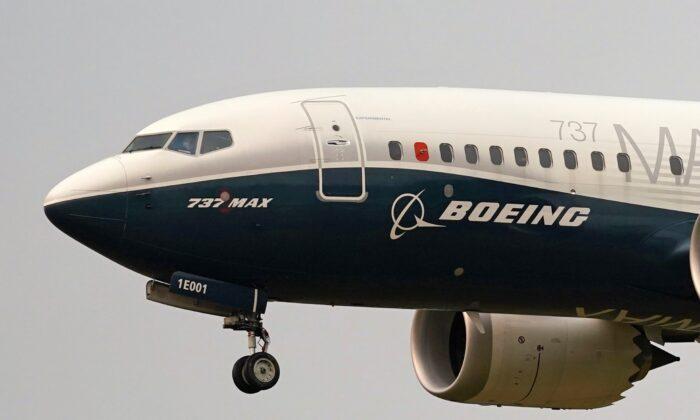Boeing’s 737 MAX 9 passenger jetliners won’t be returning to service any time soon as the Federal Aviation Administration (FAA) stated on Jan. 12 that it won’t allow the planes to be used until the agency is entirely assured of their safety.
The decision to order airlines to immediately stop flying the MAX 9s followed after a “door plug” on an Alaska Airlines plane fell off midair on Jan. 5, shortly after departure from Portland, Oregon, leaving a gaping hole in the fuselage and causing a rapid loss of cabin pressure that caused oxygen masks to drop from the ceiling.
Pilots made a safe emergency landing with 174 passengers and six crew members.
“We are working to make sure nothing like this happens again,” FAA Administrator Mike Whitaker said on Jan. 12. “Our only concern is the safety of American travelers, and the Boeing 737-9 MAX will not return to the skies until we are entirely satisfied it is safe.”
While airlines await inspection instructions from Boeing, those instructions must be first approved by the federal regulators. On Jan. 8, Boeing submitted a first round of plans to prove MAX 9’s airworthiness and get them back in service, only to have to rescind them the next day.
“Every Boeing 737-9 Max with a plug door will remain grounded until the FAA finds each can safely return to operation,” the FAA stated on Jan. 9. “Boeing offered an initial version of instructions yesterday, which they are now revising because of feedback received in response. Upon receiving the revised version of instructions from Boeing, the FAA will conduct a thorough review.”
In an update on Jan. 12, aviation regulators said they’re requiring Boeing to provide additional data before they can approve an “extensive and rigorous” inspection and maintenance process for returning MAX 9s to service.
While it was “encouraged by the exhaustive nature” of Boeing’s instructions, the FAA stated that it wouldn’t approve the plans until it reviewed data from the initial round of 40 inspections.
In another signal that the checks on MAX 9s aren’t going to finish quickly, Alaska Airlines and United Airlines, the only two U.S.-based airlines that fly MAX 9s, have extended the suspension of those flights through Jan. 16.
Alaska estimated that the cancellation would affect anywhere between 110 to 150 flights each day, while United stated that it would affect 200 flights per day.
“We regret the significant disruption that has been caused for our guests by cancellations due to these aircraft being out of service. However, the safety of our employees and guests is our highest priority, and we will only return these aircraft to service when all findings have been fully resolved and meet all FAA and Alaska’s stringent standards,” the airline stated.
Both Alaska Air and United say they found some “loose hardware” in the assembly of the door plugs—the piece that dramatically flew off midair during the incident. A door plug has a window and is placed where an emergency exit is installed in order to accommodate extra seats that require more paths for evacuation.
“Since we began preliminary inspections on Saturday, we have found instances that appear to relate to installation issues in the door plug,” United stated. “For example, bolts that needed additional tightening.”
In what’s popularly known as the Boeing 737 MAX crisis, the FAA joined other major global aviation regulators to ground the 737 MAX for more than a year because of fatal crashes in Ethiopia and Indonesia just five months apart in 2018 and 2019.
The two disasters, which killed a total of 346 passengers and crew, were both found to be tied to a design flaw in the jet’s flight control system.
The crashes also spurred numerous lawsuits against the planemaker, including one brought by the U.S. Department of Justice. In 2021, Boeing paid a $244 million fine as part of a $2.5 billion settlement, in which the Justice Department agreed to not prosecute Boeing.







